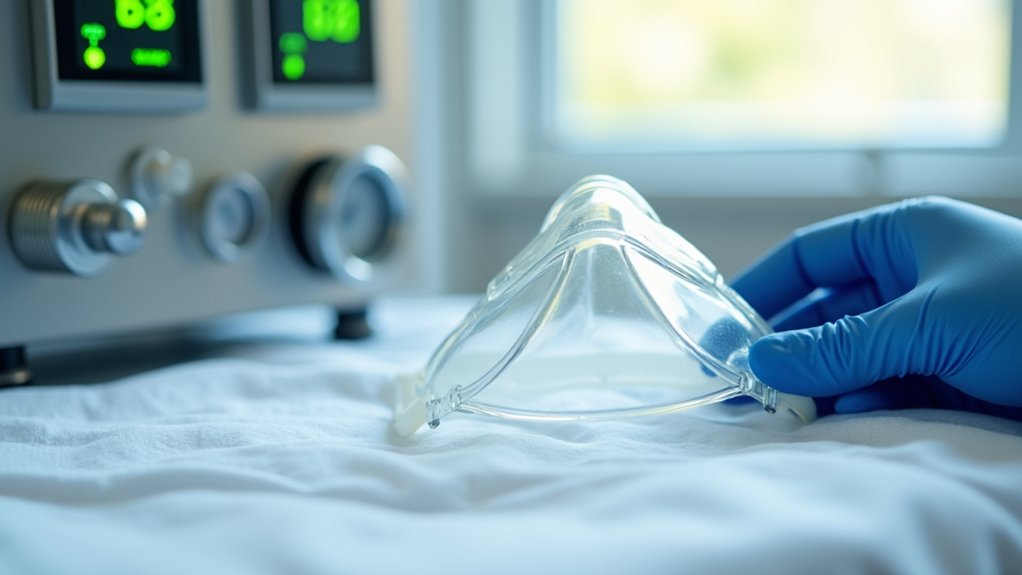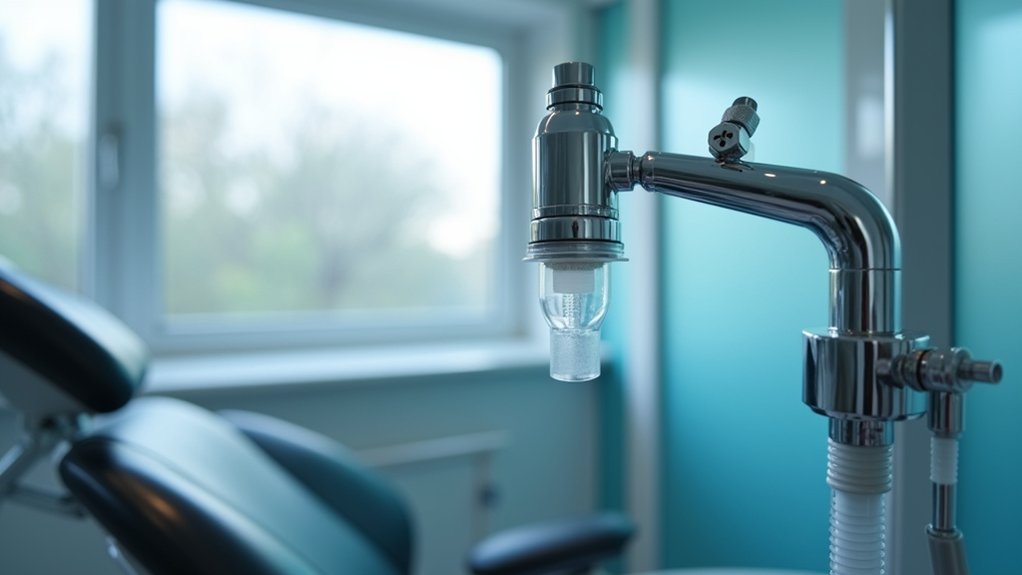When you receive nitrous oxide in medical settings, you’ll remain conscious while experiencing reduced pain and anxiety. The gas works quickly within 3-5 minutes, creating a mild euphoric sensation as it’s delivered through a mask with precise oxygen mixtures. Licensed professionals continuously monitor your essential signs throughout treatment, and effects dissipate within 5-10 minutes after discontinuation. Understanding the full scope of nitrous oxide’s medical applications can help you make informed decisions about your care options.
Common Medical Uses and Applications

Although nitrous oxide has been used in medicine for over 150 years, its versatility continues to make it indispensable across multiple healthcare settings. You’ll find this gas mixture commonly administered during dental procedures, where its ease of use helps manage anxiety and reduce discomfort during everything from routine cleanings to complex extractions. A key safety feature is that it must be mixed with oxygen during all medical applications to protect both patients and staff. The gas works by inducing opioid release in the body to help control pain sensations. In emergency medicine, you can receive nitrous oxide for acute pain management, particularly when opioids aren’t suitable. During childbirth, it offers pain relief while allowing you to remain mobile and alert. The gas has also shown promise in mental health settings, where it may assist with depression treatment. Since it is fast-acting and short-acting, patients can quickly return to normal activities after procedures. Patient satisfaction remains high due to its rapid onset, quick recovery time, and minimal side effects. You’ll maintain consciousness throughout treatment while experiencing significant anxiety and pain reduction.
Safety Profile and Risk Factors
While nitrous oxide demonstrates an exceptional safety record in clinical settings, understanding its risk profile remains crucial for ideal patient care. You’ll find comfort in knowing that over 60% of pediatric patients experience no side effects, and the medication dissipates quickly within 5-10 minutes after discontinuation. Research shows that nitrous oxide provides enhanced pain control during medical procedures. The gas allows patients to remain in a state of conscious sedation while maintaining their ability to communicate with providers.
Your healthcare provider’s adherence to prime ventilation protocols and strict safety measures guarantees your protection during treatment. The gas is delivered through systems that maintain a minimum 30% oxygen to ensure patient safety. Modern delivery systems incorporate multiple safety features, and healthcare provider education emphasizes maintaining proper oxygen ratios.
You should notify your provider if you have severe cardiovascular disease, vitamin B12 deficiency, or chronic neurological conditions, as these may contraindicate treatment. Common side effects, when they occur, are typically mild and temporary, including nausea, dizziness, or headache.
What to Expect During Administration

During your nitrous oxide administration, you’ll receive the gas through a fitted mask or mouthpiece that allows you to self-regulate your intake while maintaining ideal oxygen levels.
You’ll begin experiencing mild sedative and analgesic effects within 3-5 minutes as your healthcare provider adjusts the concentration to achieve your desired comfort level.
Throughout the procedure, your critical signs will be continuously monitored, and you’ll maintain consciousness while experiencing reduced anxiety and pain sensation.
Delivery Methods and Equipment
As you prepare for nitrous oxide administration, you’ll encounter specialized delivery equipment designed for precise control and patient safety. You’ll receive the gas through either a mask or mouthpiece that delivers a carefully controlled mixture of nitrous oxide and oxygen, typically ranging from 30-70% based on your procedure.
The equipment includes essential safety features such as flow regulators, alarms, and monitoring systems to guarantee proper gas ratios. Your healthcare team, who’ve completed extensive operator training, will adjust these controls while maintaining strict scavenging system maintenance to prevent gas leakage.
Most facilities use either fixed 50/50 mixtures or adjustable systems that allow for precise titration based on your needs. You’ll notice the mask only delivers gas when you inhale, confirming efficient and controlled administration throughout your procedure.
Sensations and Time Frame
Once nitrous oxide administration begins, you’ll experience a rapid onset of effects within 3-5 minutes. You may notice tingling sensations in your hands and feet, along with a pleasant feeling of warmth throughout your body. The gas is delivered through a soft rubber hood placed comfortably over your nose. While maintaining mental alertness, you’ll likely feel a floating sensation and mild euphoria.
Common experiences include gentle ringing in the ears and a feeling of deep relaxation. You’ll remain conscious with full procedural recollection, though pain sensations will be considerably/markedly/drastically muted. The effects typically last less than 15 minutes during treatment.
When administration stops, you’ll receive pure oxygen to clear the remaining gas from your system. Full recovery occurs within 5 minutes of termination, though you shouldn’t drive immediately afterward. Individual responses vary, but most patients report a positive, comfortable experience.
Monitoring Your Comfort Level
Your safety and comfort remain top priorities throughout nitrous oxide administration. During the procedure, your nurse will stay with you continuously, monitoring your crucial signs and consciousness levels every 5 minutes using a standardized scoring system. You’ll be regularly assessed for blood pressure, heart rate, breathing rate, and temperature changes.
You play an active role in adjusting medication dosage by communicating your comfort level. If you experience any adverse reactions like dizziness or disorientation, inform your provider immediately. They’ll respond by either modifying the nitrous oxide concentration or extending oxygen therapy as needed. Multi-parameter alarms alert staff to any concerning changes in your key signs, ensuring swift intervention. Rest assured that only licensed certified dentists can administer nitrous oxide to patients. Your recovery will be tracked using a structured flowsheet, and you’ll receive 100% oxygen for at least 5 minutes after the procedure concludes.
Benefits and Effectiveness

While nitrous oxide has served healthcare settings for over a century, modern research continues to validate its remarkable benefits and effectiveness across multiple applications. You’ll experience rapid pain relief and anxiety reduction with minimal impact on your respiratory and cardiovascular systems. Studies show that nitrous oxide can relax blood vessels to promote healthy circulation during procedures. The dosage flexibility allows for tailored patient experiences, with concentrations as low as 25% still providing significant benefits while reducing potential side effects. The gas is highly lipid soluble, making it incredibly efficient at entering the bloodstream.
You can expect quick onset of relaxation during dental procedures, minor surgeries, or other stressful medical situations. When combined with oxygen, it’s particularly effective for managing dental anxiety and procedural discomfort. What’s more, you’ll benefit from faster recovery times compared to traditional sedatives, allowing you to resume normal activities immediately after treatment.
Recent studies also show promising results in treating depression, with effects lasting up to two weeks. Patients receiving lower concentrations tend to experience fewer adverse effects while maintaining therapeutic benefits.
Key Medical Considerations
Understanding the medical considerations for nitrous oxide administration guarantees both safety and ideal outcomes. You’ll need proper evaluation for vitamin B12 deficiency management and oxygen level considerations before treatment. Medical professionals must monitor your response during procedures, especially for procedures lasting over two hours. High-concentration nitrous oxide has been safely used in thousands of pediatric cases.
| Medical Factor | What You Should Know |
|---|---|
| Duration Limit | Under 2 hours recommended |
| Oxygen Levels | Continuous monitoring required |
| Concentration | Maximum 50% nitrous oxide |
| Health Status | Pre-screening for contraindications |
| Risk Factors | B12 deficiency, respiratory issues |
If you have underlying conditions like pulmonary hypertension or require oxygen concentrations above 50%, you’re not a candidate for nitrous oxide. Your healthcare provider will assess your cardiovascular and respiratory status beforehand. They’ll also discuss potential side effects, including postoperative nausea and infection risks, ensuring you’re fully informed about your sedation options.
Patient Monitoring and Care
You’ll need to conduct regular critical sign safety checks throughout nitrous oxide administration, maintaining continuous physical presence and monitoring oxygen saturation levels, heart rate, and blood pressure.
Your facility’s equipment and alarm systems must include calibrated infrared gas analyzers for real-time concentration feedback, alongside functional emergency response mechanisms for immediate intervention if needed.
During recovery room observation, you must document the patient’s responsiveness, guarantee they remain seated or lying down, and confirm normal oxygen saturation before allowing supervised mobility.
Vital Sign Safety Checks
To safeguard patient safety during nitrous oxide administration, healthcare providers must perform systematic critical sign monitoring across multiple physiological parameters. During your procedure, medical staff will carefully track your vital signs, focusing on respiratory symptom monitoring and potential medication interactions that could affect your response to the sedation. General anesthesia may be recommended instead of nitrous oxide for more complex oral surgeries requiring deeper sedation levels. Ongoing staff training ensures proper monitoring techniques are consistently followed for patient safety.
Your healthcare team will continuously assess:
- Blood pressure and heart rate to detect any cardiovascular changes
- Oxygen saturation levels to confirm you’re receiving adequate oxygen (above 95%)
- Breathing rate and pattern to identify any respiratory issues
- Mental alertness through verbal response checks
Using a pulse oximeter, staff members will perform continuous oxygen monitoring throughout the entire procedure. These safety measures help providers quickly identify and address any concerning changes in your condition. They’ll also monitor for signs of oversedation, including excessive sweating, nausea, or difficulty following commands, adjusting treatment immediately if needed.
Equipment and Alarm Systems
Modern nitrous oxide delivery systems incorporate multiple layers of sophisticated monitoring equipment and alarm mechanisms to safeguard patient safety during sedation procedures. During your treatment, you’ll benefit from advanced dual gas flowmeters that precisely control the mixture of oxygen and nitrous oxide you receive. The system’s redundancy protocols assure uninterrupted gas delivery through backup networks while maintaining strict safety parameters. The easy-to-use controls help minimize the risk of human error during administration.
Environmental safeguards, including personal monitoring badges and PPM-level sensors, continuously track nitrous oxide levels in the treatment area. If oxygen levels drop below predetermined thresholds, fail-safe mechanisms automatically activate, cutting off nitrous oxide flow while preserving your oxygen supply. The equipment features three-tier alarm systems that alert healthcare staff to any irregularities, enabling immediate intervention if needed.
Recovery Room Observation
After the careful monitoring during nitrous oxide administration, patient observation continues in the recovery room with detailed vital sign tracking and assessment protocols. Under nursing staff oversight, you’ll receive essential monitoring of your post-procedure health status, guaranteeing your safe recovery before discharge.
Your oxygen levels, breathing rate, blood pressure, and heart rate will be tracked at regular intervals using specialized equipment. Medical staff will assess your consciousness level and ability to move safely while monitoring for any signs of nausea. Your airway remains closely observed to prevent any obstruction, with emergency equipment readily available.
You won’t be discharged until you meet specific criteria, including stable vital signs and the presence of a designated caregiver for post-procedure supervision. Your healthcare team ensures all parameters consistently meet safety thresholds before authorizing your departure from the recovery area.
Alternative Pain Management Options
Healthcare providers now recognize numerous evidence-based alternatives to nitrous oxide for managing acute and chronic pain. While cannabis-based therapies and homeopathic remedies have gained popularity, research supports several well-established approaches. Exercise programs, including aerobic and resistance training, can drastically improve function and reduce discomfort.
Cognitive behavioral therapy helps modify pain-related behaviors, while mindfulness practices enhance emotional resilience. For targeted relief, you’ll find options like topical NSAIDs, which minimize systemic side effects, and manual therapies such as spinal manipulation or massage. Acupuncture shows promising results for chronic pain management, and combination approaches often yield better outcomes.
Weight loss programs can address underlying pain triggers, while low-level laser therapy offers a low-risk intervention. Your healthcare provider can help determine which alternatives best suit your specific condition.
Current Medical Practices and Trends
Five major trends are reshaping nitrous oxide use in medical settings. Healthcare providers are increasingly adopting digital integration and smart systems that enable precise monitoring and controlled administration.
You’ll find modern facilities implementing IoT-enabled delivery devices with real-time concentration tracking and automated safety alerts. Product innovations and regulatory compliance continue to drive advancements in compact, portable systems designed for various medical environments.
- Smart delivery systems now offer patient-controlled administration options, enhancing comfort and safety during procedures
- New scavenging technologies minimize occupational exposure risks for healthcare staff
- Integrated monitoring platforms provide real-time data on gas concentrations and usage patterns
- Compact, portable delivery devices accommodate diverse medical settings while maintaining strict regulatory compliance
This digital transformation in nitrous oxide administration guarantees safer, more efficient, and better-controlled medical experiences.
Frequently Asked Questions
Can I Drive Myself Home After Receiving Nitrous Oxide?
While you can typically drive yourself home after nitrous oxide sedation due to its quick dissipation, you should first confirm this with your healthcare provider. Short-term side effects like dizziness or lingering drowsiness may affect some patients differently.
You’ll need to wait 15-20 minutes after treatment and receive clearance from your provider. If you experience any unusual symptoms, arrange alternative transportation to guarantee your safety.
Will Nitrous Oxide Affect My Ability to Breastfeed?
You can safely breastfeed after receiving nitrous oxide. There’s no evidence of potential milk supply disruption or increased risk of sedation for your baby. The gas is rapidly eliminated from your system through breathing, and it doesn’t transfer into breast milk.
You can resume nursing as soon as you’re alert and awake after the procedure. While your healthcare provider may recommend monitoring your baby’s response, complications are extremely rare.
How Long Should I Fast Before Receiving Nitrous Oxide Treatment?
You don’t typically need strict fasting before nitrous oxide administration. You can have light meals (like toast or soup) up to 2 hours before your treatment. However, it’s best to avoid heavy meals to reduce nausea risk.
You can drink water freely unless specifically instructed otherwise by your provider. If you’re receiving additional anesthesia besides nitrous oxide, your doctor may recommend a longer food intake duration restriction of 4-6 hours.
Does Dental Insurance Typically Cover Nitrous Oxide Administration Costs?
No, dental plan coverage typically doesn’t include nitrous oxide administration costs. You’ll usually need to pay for this service out-of-pocket, as most insurance providers explicitly exclude it from standard benefits.
Treatment cost considerations should be discussed with your dentist beforehand, as fees can vary drastically between practices. While some carriers might cover disposable components like masks and tubing, you should expect to bear the full cost of the sedation service itself.
Can I Develop Tolerance to Nitrous Oxide From Repeated Medical Use?
Yes, you can develop tolerance to nitrous oxide through repeated medical use. Your body may require higher doses to achieve the same pain-relieving effects over time, showing both acute tolerance during single sessions and chronic tolerance with repeated exposures.
While there’s no direct risk of dependency development, frequent use can lead to vitamin B12 deficiency and potential cognitive impairment. It’s important to discuss any concerns about tolerance with your healthcare provider.






